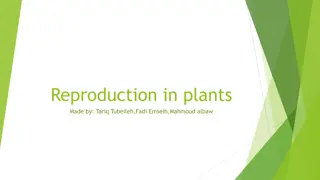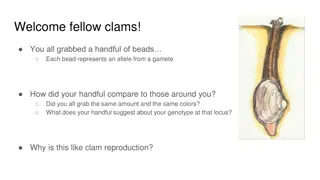Pollen Grain Development
The process of pollen grain development and formation of the male gamete involves crucial stages such as the presence of diploid microspore mother cells in the stamen, meiosis resulting in the formation of four haploid cells and tetrads, mitosis leading to the development of two haploid nuclei in ea
0 views • 6 slides
Understanding Mutations in DNA and Their Effects
Mutations in DNA are changes that can occur in body cells or gametes, leading to alterations in the genetic code. Not all mutations are harmful, but they can impact protein structure and function. Different types of mutations, such as substitutions, insertions, and deletions, can result from various
0 views • 11 slides
Understanding Average Gene Effect and Breeding Value in Animal Genetics
In the field of animal genetics and breeding, it is crucial to comprehend the average effect of genes and breeding value of individuals. Genes are transmitted from parents to offspring through haploid gametes, influencing the genotype and breeding potential. Estimating the average effect of a gene i
5 views • 26 slides
Understanding Mutations in Biology
A mutation in biology refers to changes in the nucleotide sequence of an organism's genome. These alterations can either be harmful, leading to conditions like cancer, or beneficial, such as providing antibiotic resistance. Mutations can occur in somatic cells or gametes, affecting both the individu
1 views • 18 slides
Understanding Meiosis: Key Concepts in Biological Evolution
Meiosis is a crucial process in organisms, involving the formation of haploid gametes with unique allele combinations. This process ensures genetic diversity through crossing over and independent assortment, leading to variations essential for evolution. The significance of homologous chromosomes, d
1 views • 22 slides
Understanding Algal Sexual Reproduction and Life Cycles
Algal sexual reproduction involves various types of gametes, from isogamy to oogamy, with distinct sizes and motility. Algae exhibit different life cycles like haplontic, diplontic, and diplohaplontic, each characterized by specific mechanisms of meiosis and stages of haploid and diploid phases.
0 views • 24 slides
Understanding Different Types of Reproduction in Organisms
Unwanted materials can be passed directly or indirectly, impacting the complexity of systems and bodies. Reproduction methods include sexual and asexual, each with unique processes and characteristics. Asexual reproduction involves division and growth, while sexual reproduction combines hereditary i
1 views • 105 slides
Understanding Chromosomal Abnormalities and Syndromes
Human cells have 22 pairs of autosomes and one pair of sex chromosomes, totaling 46. Karyotypes help diagnose chromosomal abnormalities by aligning chromosomes in size order. Nondisjunction during meiosis can lead to abnormal chromosome numbers in gametes. Disorders like Down Syndrome, XYY Syndrome,
0 views • 30 slides
Understanding Meiosis and Genetic Variation in Organisms
Meiosis forms variable gametes in organisms, leading to increased genetic variation through the production of haploid gametes by meiosis I and II. Key concepts include homologous chromosomes, crossing over, independent assortment, and linked genes. Terminology such as homologous pairs and human chro
0 views • 29 slides
Overview of Cell Division Processes: Mitosis and Meiosis
Cell division involves two main processes: mitosis and meiosis. Mitosis is responsible for the division of somatic cells, producing identical daughter cells. It consists of prophase, metaphase, anaphase, and telophase, followed by cytokinesis. In contrast, meiosis is crucial for the formation of gam
4 views • 37 slides
Understanding Hormones and Reproductive Changes in Adolescence
Changes during adolescence are driven by hormones like testosterone in boys and estrogen in girls, leading to physical developments such as facial hair growth and breast development. Hormones play a crucial role in initiating reproductive functions, with endocrine glands releasing hormones to target
0 views • 19 slides
Factors Affecting Puberty and Reproduction in Animals
An animal reaches puberty when it can release gametes and exhibit complete sexual behavior. Puberty age varies across species, influenced by factors like breed, climate, nutrition, and management. Smaller species generally reach puberty earlier than larger ones. Climatic conditions and genetics also
0 views • 28 slides
Understanding Gametogenesis and Oogenesis Process in Humans
Gametogenesis is the formation of gametes from germ cells in the testes and ovaries, involving meiosis and cytodifferentiation. Oogenesis specifically refers to the differentiation of oogonia into mature oocytes, with prenatal oogenesis occurring before birth and postnatal oogenesis after birth. The
0 views • 17 slides
The Process of Mitosis and Meiosis in Watermelons
Watermelons undergo the processes of mitosis and meiosis to grow and reproduce. During mitosis, watermelons develop through interphase, prophase, metaphase, anaphase, and telophase. In meiosis, seeded watermelons produce gametes through prophase I, metaphase I, anaphase I, and telophase I. Both proc
0 views • 16 slides
Plant Reproduction and Life Cycles in Biology II for Non-Majors
Explore the complex processes of plant reproduction, life cycles, and the alternation of generations in biology. From the fusion of male and female gametes to the development of sporophytes and gametophytes, delve into the stages and structures involved in the reproduction of gymnosperms and angiosp
0 views • 25 slides
Development of Female Gamete and Embryo Sac in Plant Reproduction
In plant reproduction, the formation of female gametes involves meiosis in cells of the carpel sac, leading to the development of the embryo sac or megaspore. Meiosis results in four haploid cells, of which three degenerate, and one survives. This surviving cell undergoes multiple rounds of mitosis,
0 views • 7 slides
Understanding Reproduction in Plants: Types, Processes, and Examples
Reproduction in plants involves both sexual and asexual methods, each with distinct processes and outcomes. This article delves into the types of reproduction, including sexual and asexual processes, explaining their mechanisms, examples in plants, and the importance of pollination. It contrasts ase
0 views • 25 slides
Flowering Plant Reproduction: Pollination, Fertilisation, and more
Explore the process of pollination and fertilisation in flowering plants through an interactive quiz. Learn about the fusion of gametes, formation of endosperm and zygote, seed development, and more. Test your knowledge on plant reproduction and understand the intricate mechanisms involved.
1 views • 50 slides
Genetics and Cell Division Study Guide
Explore topics ranging from cell division phases, mitosis stages, genetic variation in sexual reproduction, chromosome structures, karyotypes, Mendel's laws, Punnett squares, and more in this comprehensive study guide. Understand key concepts such as DNA replication, chromosomal abnormalities, gamet
0 views • 46 slides
Non-Mendelian Genetics Foldable
Explore the world of non-Mendelian genetics through a hands-on foldable activity. Learn about codominance, incomplete dominance, multiple alleles, epistasis, polygenic traits, gametes, and more in a visually engaging manner. Understand how traits are inherited and expressed in ways beyond traditiona
0 views • 10 slides
Understanding Genetic Inheritance and Reproduction
Delve into the world of genetic inheritance and reproduction through topics such as gametes, fertilization, allele definition, genotype versus phenotype, dominant versus recessive traits, and the process of sexual reproduction. Explore how genetic information is passed on from parents to offspring,
0 views • 41 slides
Understanding Gametogenesis and Spermatogenesis in Living Organisms
Gametogenesis is a vital process in living organisms where germ cells develop into gametes for reproduction. Spermatogenesis, specifically in males, involves phases like multiplication, growth, and maturation to produce sperm. This intricate process ensures the perpetuation of species through the fo
0 views • 49 slides
Understanding Genetic Principles Through Clam Reproduction
Explore the concept of allele inheritance using beads as gametes, relating it to clam reproduction. Discuss gamete fusion probabilities, Hardy-Weinberg Equilibrium, and frequency predictions in population genetics.
0 views • 32 slides






















